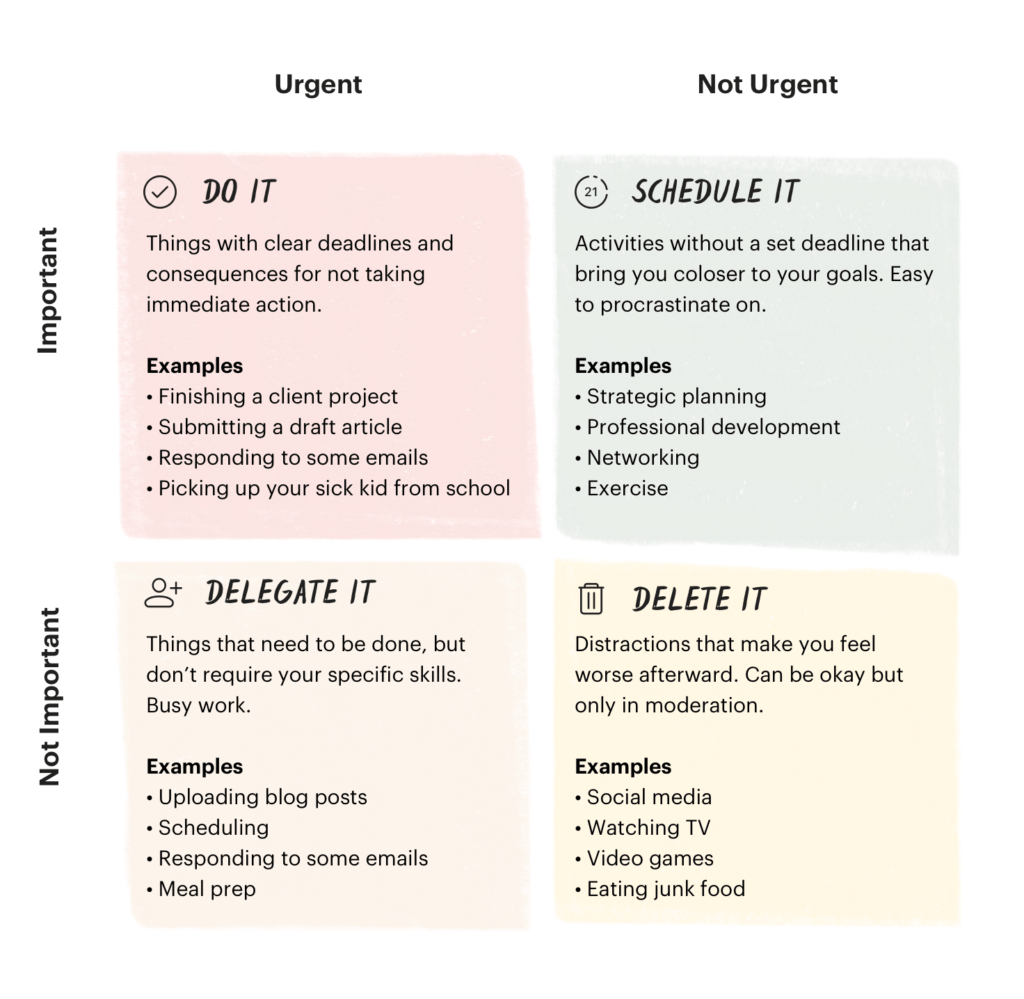Any work can be stressful at times. But if every Monday you’re feeling panicked at the growing pile of tasks in your inbox, it’s time for priorities management. This powerful technique can help you tackle the feeling of permanent anxiety and push you towards completing your goals stress-free.
In this article, we’ve gathered the most practical methods, techniques, and tools (including the best time tracking software) to help you prioritize your tasks effectively and become the master of your time.
What Is Priorities Management AKA Prioritizing?
Every project manager has spotted the following “prioritization” definition in almost every time management book they read:
Priorities management is the act of putting tasks or work in a particular order so that you and your team are more efficient.
…And it’s great to learn about it in theory. But when it comes to putting it into practice? Well, that’s the more difficult part. To get there, we need to go back to basics and tell the difference between time management and prioritization. Both look similar though have distinct ideas in their cores. So, what’s the difference between time management and prioritization?
Time management is aimed at task planning and time control. Prioritization is about ranging tasks from the most to the least important. When setting priorities, project managers usually rely on the two main factors — urgency and importance (read how to improve your sense of urgency). These two form the foundation for every prioritizing technique or strategy.
Let’s take a look at the most effective ones below so that you can successfully prioritize your daily tasks and ambitious goals for the future!
Why You Can’t Live Without Priorities Management?
So, why do you need priority management in your work? Whether you’re a project manager, have your own startup, or simply work for a company it’s essential for you to develop your prioritizing skills. Prioritizing allows you to:
- Avoid anxiety and burnout by setting a limited and achievable number of tasks you can do throughout a working day.
- Enhance your working capacity, aligning all your tasks with the current business needs.
- Better manage your work-time balance and find time for work and rest in your schedule. Get that work-life balance.
- Learn what’s best for your business by defining the most valuable tasks and fulfilling them first.
- Improve the work of your employees by training them on how to be the ultimate task manager of their own priorities at work.
7 Effective Priorities Management Techniques
Before you get too far into priorities management, let’s take a moment and examine your current daily routine. How do you prioritize your work? Understanding what you’re currently doing with your time is the first step to better being able to optimize it.
Done? Good. Now, let’s learn how to prioritize your projects and activities. Start with these 7 techniques for priority management.
1. Sorting tasks with Master List
If your task list is always full, you’ll already know the benefits of a Master List. It helps you to systematize your working schedule for a month in advance and adjust it if the need arises.
For this activity, take 4 sheets of paper and a pen. Each paper represents the tasks you have to complete at different time periods—monthly, weekly, daily—and a Master List for all the tasks.
Master List procedure:
- Step 1. Lean back in an armchair with a cup of tea and make a list of all tasks you need to do in your Master List. These activities can include the most important things and the less significant ones, basically, all the duties you keep in your head.
- Step 2. As soon as you form your Master List, recheck it. You’ll notice that these tasks have different priorities and urgency. Some of them you have to do this week, others you can put off for a month.
- Step 3. Sort out the tasks that matter for your business into the monthly, weekly, and daily goals. To ensure that your long-term goals align with the short-term ones, you need to pull your monthly list from your Master List, your weekly list from your monthly list, and your daily list from your weekly list.
👉 This smart prioritization technique can help your business to achieve big goals in perspective. For this, you should break this big goal into smaller ones and incorporate them into your monthly-weekly-daily lists.
2. The Ivy Lee Prioritization method
When each of your tasks is a priority, you have to get deeper to know which one should be first, second, and so on in your list. For this, you could use the wisdom of a successful businessman Ivy Lee. He invented this prioritization approach in the distant 1920s. Since then it has remained popular as one of the most effective productivity-enhancing techniques.
The Ivy Lee Prioritization method steps:
- Step 1. Before going to bed, jot down the 6 most important tasks you want to fulfill tomorrow (limit yourself to only 6 tasks).
- Step 2. Range the 6 items in order by importance.
- Step 3. The next day as you get to work concentrate on your first task and complete it. Don’t start the second task until you have the first one done.
- Step 4. Get through your list and do your tasks sequentially. If at the end of the day you have several items left, just move them to your new 6 tasks list for the forthcoming day. Repeat this process daily.
👉 Picking only 6 tasks a day helps you to stay focused on the most essential things. It also relieves psychological pressure when you have to complete too many things. If you feel like you need to include more than 6 tasks in your daily list, then consider how to delegate some of them.
3. Warren Buffett’s 2-list strategy
What if you can’t define your long-term goals clearly? Warren Buffett will help you with his simple but at the same time workable technique!
Warren Buffett is one of the most successful investors in the world and is currently one of the richest people today at age 90 years old. To help him succeed, he invented a special strategy that helped him concentrate on the most valuable goals in his career.
That’s how Warren Buffett’s 2-list strategy works:
- Step 1. Write down your top 25 priorities of a lifetime. These priorities can include life, education, or career goals.
- Step 2. From these 25 items circle the top 5 most important ones.
- Step 3. Now, concentrate on your top 5 essential goals and avoid the rest at all costs until you succeed in those 5.
👉 The best part of this technique is that you can apply it to any aspect of your life, starting with a career, ending with things you want to study in college. And who wouldn’t want to get some of Buffett’s success?!
4. Eisenhower Matrix
From long-term goals to a daily routine. You already know how to rank your tasks by importance but what if you need to prioritize them by urgency as well? The Eisenhower Matrix will help you sort out the most important tasks by their urgency so that you know where to start.
Dwight Eisenhower invented this method based on the experience he got from managing the US Army in WWII and serving as the 34th president of the US. The Eisenhower Matrix helped him to make the toughest decisions.
Eisenhower Matrix steps:
- Step 1. Take a piece of paper and draw a big square. Add 2 more lines and divide a big square into smaller ones, so that you have 4 smaller squares in a big one.
- Step 2. From the lower-left square to the upper left square you’ll place your tasks by importance.
- Step 3. From the lower-left square to the lower right square you’ll place your tasks by urgency.
As you put all your tasks in the squares, have a look at your Eisenhower Matrix. It’ll tell you what to do next. Eisenhower Matrix includes the following squares:
- Urgent and Important: the tasks you’ll need to do first.
- Not urgent but Important: the tasks that you’ll do later.
- Urgent but Not important: the tasks you should delegate.
- Neither urgent nor important: the tasks you need to avoid.

👉 Eisenhower Matrix teaches you how to prioritize your tasks and delegate part of them to your employees. Delegating might be the toughest part of the matrix as you have to learn how to do it effectively!
5. Circadian rhythm
The Circadian rhythm, aka your body clock, is a sleep-wake process that our bodies naturally have. The body clock tells us when to be active, hungry, or tired. Though it is a genetic thing, we can change our circadian rhythms with age or adjust them to our lifestyles. There are two main categories in circadian rhythms:
🐦 Early birds, aka larks, are active in the early hours. They wake up with the rising sun and go to bed before midnight.
🦉 Night owls are highly energetic at night and love sleeping in the daytime.
By tracking your circadian rhythms, you can identify the most and least productive hours throughout the day.
👉 This will help you to align your most energetic time with the amount of work you have to complete. All you need is to track your working time and measure when you were the most effective during the day.
6. The ABCDE method
If you work on several projects and have lots of important tasks, keeping up can be a challenge. So why not give the ABCDE Method a go? Many project managers apply the ABCDE Method to sort out arrays of projects they get daily at work. And though these projects can have various complexity, the ABCDE Method is simple and extremely helpful to use. Here’s how it works.
The ABCDE Method steps:
- Step 1. Take a piece of paper and divide it into 5 columns. Each column should have a letter: A – very important, B – important, C – nice to do, D – delegate, E – avoid if possible.
- Step 2. Sort out all of your tasks between the columns. You should evaluate the importance of each task by the negative consequences you will get in case you don’t complete the task.
- Step 3. Now, you need to order your tasks in each column. It means that you have to assign each task a number that signifies in which order you’re going to handle the task.
👉 The ABCDE Method helps to define the position of each task by its importance. For example, when tasks are jumbled together in one pile it’s quite difficult to define, which is the more important B1 or A3 task. Though once you put all the tasks in a logically ordered table, you can clearly see your priorities.
7. Eat the Frog technique
Eat the Frog is a post-prioritization technique aimed at saving you time and allowing you to get more done. It has no steps in particular. Instead, it follows one simple rule—do the most unpleasant task as early as possible.
So why is it called “eat your frog?” Well, because of Mark Twain. Once he famously wrote: “If you have to eat a live frog, it does not pay to sit and look at it for a very long time!”
This basically means “don’t suffer from your procrastination, just go and do the most unpleasant task fast and early so that you could enjoy the rest of your day”.
👉 If you eat your frog enthusiastically at the beginning of your working day, it’ll help you finish with the rest in good spirits. This way, if you put one frog a day at the top of your list, you’ll get through all those tasks in no time. From the most important to those that can wait a while.
Lastly, if you need to save yourself some more hours, check out some more effective time management techniques.

Winning Techniques for Time Management
A list of highly effective time management techniques you can follow to improve your focus and productivity, reduce stress, and get more done every day
Wrap Up
Knowing how to manage your priorities in work is the key to effective project management. It allows you to set your tasks, rating them by urgency and importance, and gives you a clear vision of long-term goals. In doing so, you’ll find you not only have more success in getting work done, you’ll be less stressed, too. While it does take a little bit of time to get things right, after a while, priorities management becomes like second nature.
We, at Everhour, hope that this article was useful for you and helps you to manage your schedule better. Don’t forget, Everhour has some great time tracking software for tracking your time to help you prioritize tasks by time, budget, and other factors at play!
If you are managing a team of 5 or more and looking to boost efficiency, Everhour is the perfect tool to keep your team on track. With seamless time tracking, you can easily estimate task durations, set clear budgets, and generate detailed reports inside Asana, Trello, Jira, or any other pm tool.
- Featured image credit: MPOWR

